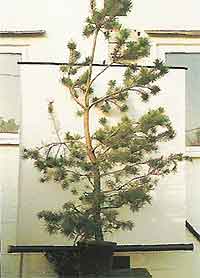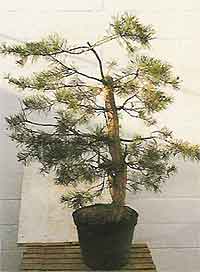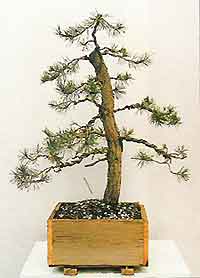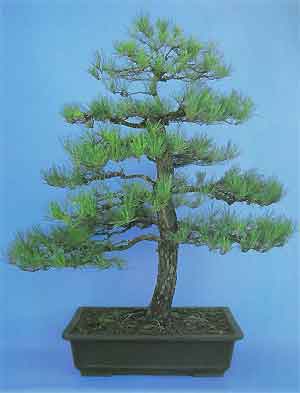Bonsai Trees
Case Histories
Scots Pine - (pinus sylvestris)
Scots Pine Bonsai Style: Informal Upright

Over the years I have been lucky enough to become good friends with the staff at my local nursery. With more than twenty acres of plants, either in pots or growing in the open ground, they are mainly wholesale. I am often allowed to wander the whole site when I am looking for potential bonsai material. On this particular occasion, one summer's morning, I was walking around the nursery hoping to find a large pine tree.
At this time I had few pines in my collection and wanted the opportunity to further my knowledge and experience with this species. Noticing a row of very large pines lined alongside a lorry I went to investigate. They were Scots pines, apparently all destined for a nearby golf course that afternoon.

Most were clearly not suitable for bonsai training, being too tall and lacking lower branches, however I spotted one which looked very appealing. Despite being over 2 metres (7 feet) tall, the thick trunk contained many small branches lower down.
The bark had an aged appearance and I persuaded the manager that this tree should come home with me! With a little friendly negotiation we agreed a very favourable price (for me!) and I loaded the pine into my trailer, which I had brought in case.
Scots Pine Bonsai History: Training

One Sunday morning during the winter, I was invited to a fellow enthusiasts house for a 'bonsai day', with several other keen bonsai growers. I decided to style this pine, which I thought would keep me busy and spent the whole day working my way up the tree, wiring and shaping each branch as I went. Pines have the great advantage of being very flexible and I was able to successfully reposition some fairly thick branches. It was a most productive day and also a very social occasion!
In the spring the pine was planted in a training box and positioned in full sunlight. After some candle pinching, small buds started to form on the branches much closer to the trunk. I could not prune these branches back to the more suitable buds yet, as the end shoots of the branch were required to keep the sap flowing. Pruning at this stage would have killed the new buds and so I waited patiently for one year, then reduced the length of many of these long branches.

The pine was completely structured and all the branches were re-wired. Unfortunately the main and most important branch on the tree had not budded back and was spoiling the overall appearance. As the tree was an evergreen and the branches would never be seen without foliage, I was able to employ an interesting technique to improve this branch. The shoots were twisted, coiled and 'snaked' to shorten them and bring the foliage closer together. Some growth was bent back towards the trunk, filling in the bare areas of the branch. Although at this stage it was obvious what I had done, I was confident that in several years the branch would be dense and this twisted structure completely hidden from view with lush foliage. The tree remained in the box for a further two years.
After over four years of training the branches of the pine were still not as dense as I had hoped and the pine was therefore planted in the garden to grow on. When the tree had been growing in the ground for three years it was at last planted in a bonsai pot. The roots were very healthy, being covered in beneficial white mycorrhyzal fungus, which helps them absorb nutrients. Further wiring was carried out, partly flattening out the foliage so that the spring candles could begin to create well shaped pads. Downward growing needles were pulled out to give the branches clean lines and the apex was thinned to reduce its vigour.
Looking back, I consider myself very fortunate that I visited the nursery on that particular day. Had it been just one day later, this impressive and individual bonsai would have been just another pine tree growing on a golf course.
 Over the years I have been lucky enough to become good friends with the staff at my local nursery. With more than twenty acres of plants, either in pots or growing in the open ground, they are mainly wholesale. I am often allowed to wander the whole site when I am looking for potential bonsai material. On this particular occasion, one summer's morning, I was walking around the nursery hoping to find a large pine tree.
Over the years I have been lucky enough to become good friends with the staff at my local nursery. With more than twenty acres of plants, either in pots or growing in the open ground, they are mainly wholesale. I am often allowed to wander the whole site when I am looking for potential bonsai material. On this particular occasion, one summer's morning, I was walking around the nursery hoping to find a large pine tree. Most were clearly not suitable for bonsai training, being too tall and lacking lower branches, however I spotted one which looked very appealing. Despite being over 2 metres (7 feet) tall, the thick trunk contained many small branches lower down.
Most were clearly not suitable for bonsai training, being too tall and lacking lower branches, however I spotted one which looked very appealing. Despite being over 2 metres (7 feet) tall, the thick trunk contained many small branches lower down. One Sunday morning during the winter, I was invited to a fellow enthusiasts house for a 'bonsai day', with several other keen bonsai growers. I decided to style this pine, which I thought would keep me busy and spent the whole day working my way up the tree, wiring and shaping each branch as I went. Pines have the great advantage of being very flexible and I was able to successfully reposition some fairly thick branches. It was a most productive day and also a very social occasion!
One Sunday morning during the winter, I was invited to a fellow enthusiasts house for a 'bonsai day', with several other keen bonsai growers. I decided to style this pine, which I thought would keep me busy and spent the whole day working my way up the tree, wiring and shaping each branch as I went. Pines have the great advantage of being very flexible and I was able to successfully reposition some fairly thick branches. It was a most productive day and also a very social occasion! The pine was completely structured and all the branches were re-wired. Unfortunately the main and most important branch on the tree had not budded back and was spoiling the overall appearance. As the tree was an evergreen and the branches would never be seen without foliage, I was able to employ an interesting technique to improve this branch. The shoots were twisted, coiled and 'snaked' to shorten them and bring the foliage closer together. Some growth was bent back towards the trunk, filling in the bare areas of the branch. Although at this stage it was obvious what I had done, I was confident that in several years the branch would be dense and this twisted structure completely hidden from view with lush foliage. The tree remained in the box for a further two years.
The pine was completely structured and all the branches were re-wired. Unfortunately the main and most important branch on the tree had not budded back and was spoiling the overall appearance. As the tree was an evergreen and the branches would never be seen without foliage, I was able to employ an interesting technique to improve this branch. The shoots were twisted, coiled and 'snaked' to shorten them and bring the foliage closer together. Some growth was bent back towards the trunk, filling in the bare areas of the branch. Although at this stage it was obvious what I had done, I was confident that in several years the branch would be dense and this twisted structure completely hidden from view with lush foliage. The tree remained in the box for a further two years.